This site is part of various affiliate programs. Links may give us a small compensation for any purchases you make, at no additional cost to you. Please read the disclaimer policy for full details.
If you don’t have the time to read this article, then when comparing the Contax T2 vs TVS, the TVS is a more technologically advanced camera with a 28-56mm zoom lens that is a stop or two darker than the T2. The T2 has a brighter fixed 38mm lens and an $800 higher price point. Both cameras look equally fabulous and are equally tough.
If you are in the market for a point-and-shoot film camera and you’ve started doing some research, you’ve probably already come across Contax or at least Kyocera-designed cameras.
Contax is a brand name that Kyocera used for the higher-end rangefinder cameras, and the Contax T series is a point-and-shoot camera family intended for the pros. Consider it the more luxurious brand of camera made by Kyocera. Yashica is the more budget-oriented camera family.
Just like mirrorless cameras nowadays are the more compact versions for the DSLRs, in the days of film, the rangefinders were the analogs for mirrorless cameras. In this article, we will take a look at two highly sought-after point-and-shoot pro rangefinder cameras: the Contax T2 vs Contax TVS.
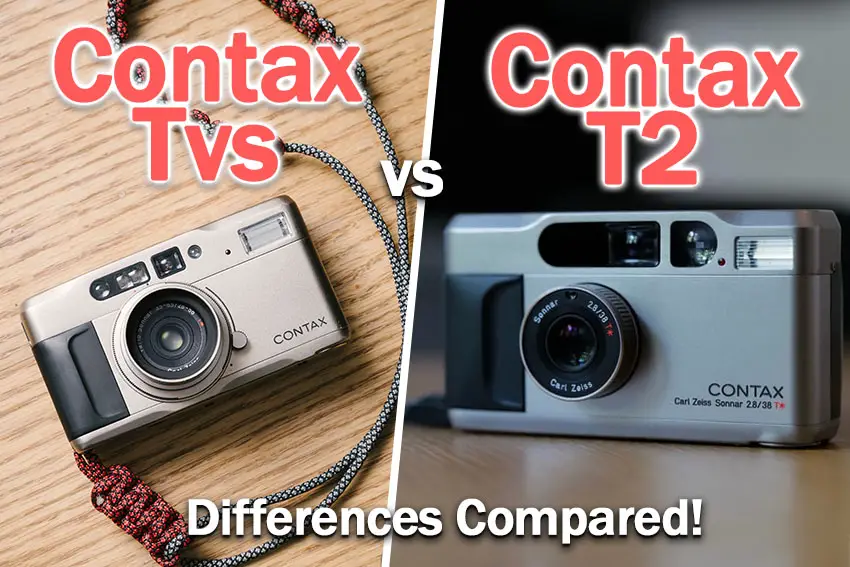
Contax T2 Overview
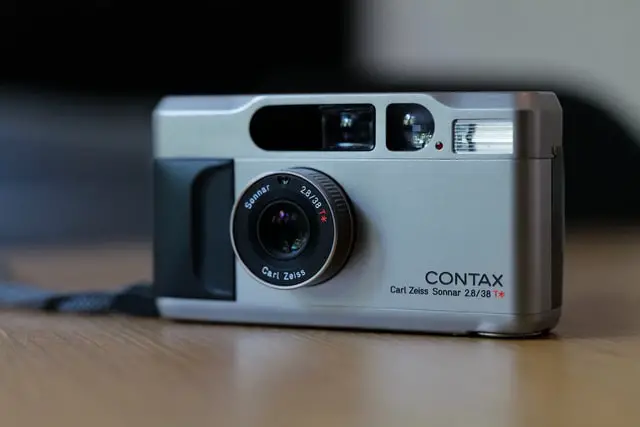
Features:
- Film: 35mm, DX ISO 25-5000, Non-DX Default ISO 100
- Lens: Carl Zeiss T* Sonnar 38mm f/2.8
- Aperture Range: f/2.8 – f/16
- Shutter Speed: 8s – 1/500s
- Exposure Compensation: +/- 2 EV in ½ EV Steps
- Size: 119x66x33mm
- Weight: 296g
The Contax T2 was released back in 1990, and it took the high-end market by surprise. It competed with the Leicas at a lower price but was equally luxurious, targeting the very same professionals that carried a point-and-shoot camera. The Carl Zeiss T* lens was a great selling point since Zeiss lenses are always well made and incredibly sharp.
It featured a retractable lens, fully automatic functionality, built-in flash, and aperture priority for those photographers that wanted a bit more control. You could manually focus the 38mm f/2.8 lens if you so desired by using a distance dial, or you could use the quite reliable autofocus that the camera had.
All that was encased in a titanium body, with stylish design, intuitive controls, and great mechanics. The design and style of the camera make it quite desirable nowadays, with celebrities using them more and more as a fashion statement (and we hope they do some photography with them too). The size and weight of the camera make it quite pocketable, which is great.
Sadly, the celebrity status of the T2 doesn’t bode well for the price causing it to skyrocket lately.
The camera, as any camera for that matter, has a flaw or two. Most of the negative things you’ll notice about this camera is regarding the f/2.8 aperture. Even though the lens is superbly sharp at f/2.8, you can’t use it in aperture priority.
If the camera picks f/2.8 in auto mode, the shutter speed is limited to 1/200s, a considerable step down from the 1/500s maximum shutter speed for all other apertures.
- Pros:
- Fantastic looks and retro design that appeals even to celebrities.
- Quite durable due to the titanium build and casing.
- The lens is incredibly sharp.
- You can use it in fully automatic mode or in aperture priority mode.
- Cons:
- You can’t select f/2.8 in aperture priority.
- At f/2.8, the fastest shutter speed reduces to 1/200s.
- Shutter speed and aperture readouts in the viewfinder can be confusing.
Contax T2 Photo Examples
Contax TVS Overview
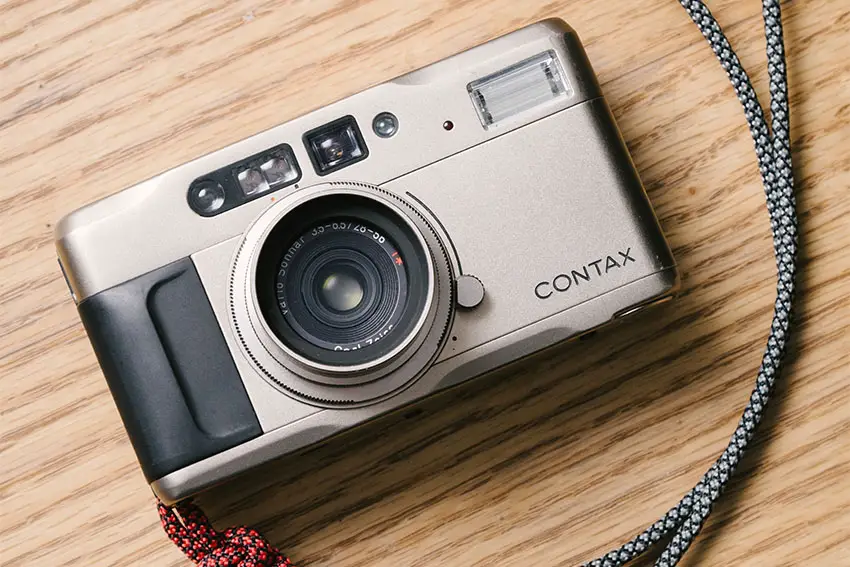
Features:
- Film: 35mm, DX ISO 25-5000, Non-DX Default ISO 100
- Lens: Carl Zeiss T* Vario Sonnar 28-56mm f/3.5-6.5
- Aperture Range: f/3.5 – f/16
- Shutter Speed: 16s – 1/700s
- Exposure Compensation: +/- 5 EV in 1/3 EV Steps
- Size: 123x67x41.5mm
- Weight: 375g
The TVS, being released four years after the T2, gets a couple of new technologies to improve over the T2. The main and the most apparent difference between the two cameras is that the TVS has a zoom lens instead of a fixed one.
The Carl Zeiss T* Vario Sonnar lens zooms 2x from 28mm to 56mm. As a downside, it loses some light at the wide end. At 28mm, it is f/3.5, which isn’t that bad. But in the long end, it drops to f/6.5, which can be a problem in low light scenarios.
Kyocera improved the autofocus on the TVS by adding an IR passive system that is assisted by an AF assist lamp when it gets darker, ensuring fast and accurate focus for that time.
The shutter mechanism was also updated slightly, allowing for a bit faster maximum shutter speed, and the exposure compensation is increased to +/- 5EV in more granulated ⅓ of a stop increments.
It is obvious that Kyocera wanted to improve and polish the T2 by adding more functionality incrementally. Instead of making giant, risky leaps, they stuck to what worked well and just improved it slightly while still keeping the TVS competitive.
The TVS mainly uses the T2 body design. Meaning the same titanium, the same curves, the same rigidity, and essentially the same styling. Don’t be surprised if you mistake the TVS for the T2 at first glance or vice versa.
Handling-wise, the TVS is a bit heavier but still pocketable, gaining just a couple of millimeters here and there.
Since the TVS (like the T2) has its shutter mechanism in the lens, the aperture essentially works as a shutter mechanism. There is some restriction on the maximum shutter speed when wide apertures are used, which drops to 1/500s at f/3.5.
- Pros:
- Looks wise almost identical to the T2.
- Quite durable due to the titanium build and casing.
- The lens is incredibly sharp.
- You can use it in fully automatic mode or in aperture priority mode.
- Improved autofocus.
- +/- 5EV of exposure compensation in ⅓ stop increments.
- Zoom lens.
- More affordable.
- Cons:
- The zoom lens is quite dark at the telephoto end.
- Wide apertures restrict maximum shutter speed.
- The lens flex cable is known to break often.
Contax TVS Photos
Below are a handful of Contax TVS photo examples to give you an idea of how it handles.
Contax T2 vs TVS Comparison
It is time to put these cameras up against each other, feature by feature. That way, you can better compare the characteristics of these fairly similar cameras and make a better-informed decision on which one is the right choice for you.
Lens Quality
Both cameras have Carl Zeiss T* lenses. In fact, every Contax will have one, and that is a benefit from the get-go. However, the main difference between the lenses on these cameras is that one is a 38mm f/2.8 prime lens, while the other is a 28-56mm f/3.5-6.5 zoom lens.
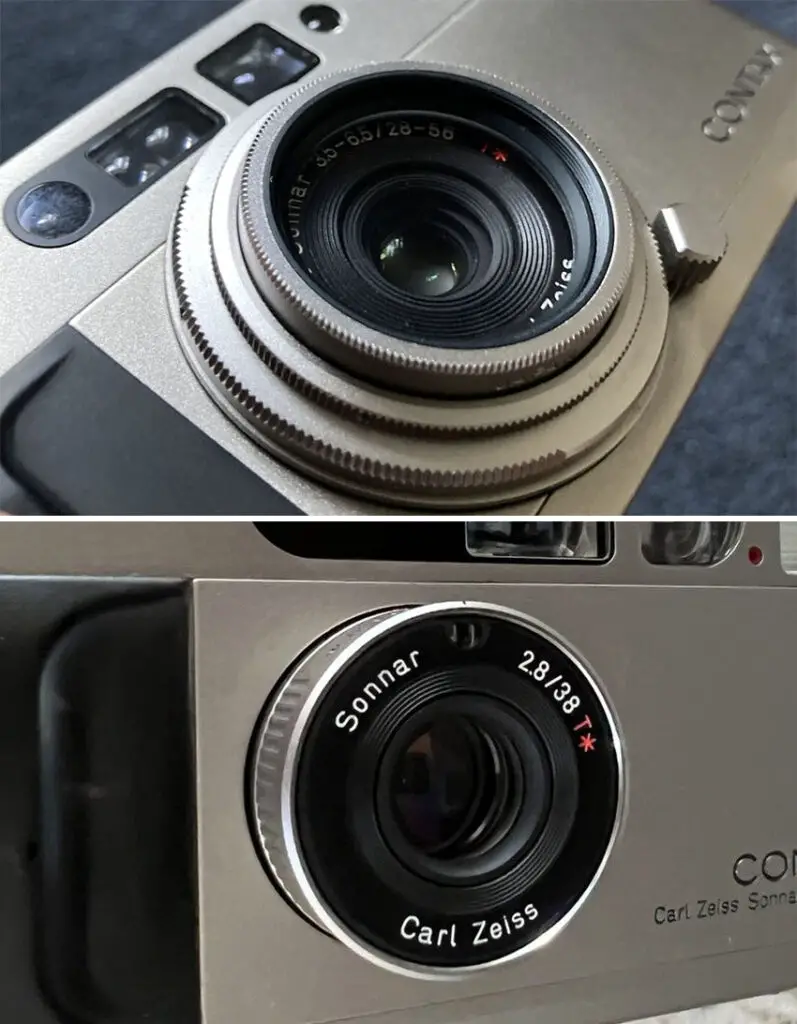
Both lenses are Sonnar, meaning they are mid-range Carl Zeiss T* lens designs with outstanding optical quality. Both lenses will be sharp and well-corrected for chromatic aberration and flaring.
However, the Vario Sonnar on the TVS has a starting aperture of f/3.5, which drops significantly to f/6.5 when you zoom in to 56mm. That can be a problem if you shoot in low light.
When you set the Vario Sonnar to 38mm, the lens will be around f/4.5, so the TVS at the same focal length is at least 1 ⅓ of a stop darker when compared to the T2.
So, in summary, the T2 has a fixed 38mm lens with an f/2.8 aperture, while the TVS can go wider and more telephoto than the T2 with the 28-56mm lens at the cost of it being slightly to significantly darker depending on how zoomed in the lens is.
Autofocus
Both cameras feature fairly accurate autofocus systems. However, the TVS has a slightly more advanced autofocus system, allowing it to focus faster and more accurately when compared to the T2.
Since the TVS has a narrower aperture, the autofocus has a bit more leeway in the sense that it can miss by a fraction. You won’t notice it due to the larger field of focus.
You’ll get good autofocus with both cameras, but the TVS will be slightly more accurate and faster than the T2. Will it change much for your photography? Probably not, but it will save you a frame or two in a film with less out of focus photos.
Shooting Modes and Usability
As you probably assumed, both cameras can work in full auto or aperture priority. After all, they are pretty similar. Both cameras receive a shutter speed penalty when they are at the widest aperture due to the shutter being the aperture itself.
However, in the widest aperture at f/3.5, the TVS can manage 1/500s shutter speed, matching the T2 at the same aperture. At f/2.8, the T2 drops to 1/200s which is a bit slow, even for the 1990s. The TVS manages 1/700s fastest shutter speed, while the T2 tops out at 1/500s.
The TVS features a top LCD showing the exposure compensation and flash mode, whereas the T2 does not. So the TVS provides more information to the user.
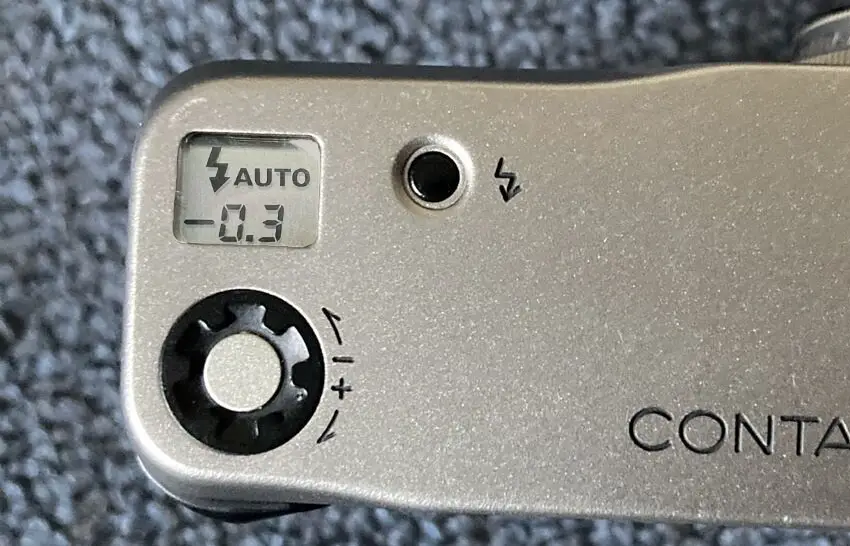
The T2 has two modes, aperture priority and fully automatic. The TVS has both, but if you miss the exposure too much in aperture priority, the camera will automatically correct it for you. So aperture priority is only partially manual.
In summary, the T2 has slower maximum shutter speeds, while the TVS can manage faster shutter speed even when the aperture reduces the fastest shutter speed. On the other hand, the T2 will let you use aperture priority completely manually, while the TVS might override it if the exposure is too far off.
Style and Design
At first glance, both cameras are pretty similar. The camera’s body shape is nearly identical. The TVS has a larger window for the autofocus system since it is more advanced, and the lens protrudes further. It also weighs about a third more.
The T2 lacks the top LCD screen that the TVS has. Both cameras feature an excellent viewfinder, and the TVS one zooms in because it is coupled with the lens. That is great.
Both cameras feature the same titanium finish and the same tough and rugged design due to the materials used.
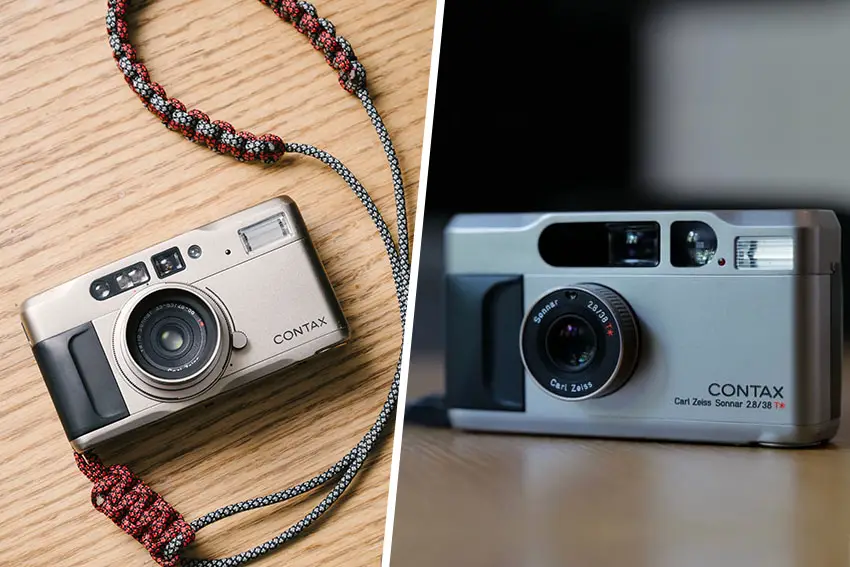
Stylistically, they don’t differ much, if at all. You can easily confuse one for the other at first glance. So if looks matter to you, they are equally awesome.
In short, both cameras are as tough as nails and look equally fabulous. From a design standpoint, they look equally fashionable. The TVS has an extra LCD screen on the top, which the T2 doesn’t have.
Price
Sadly, these cameras aren’t free. Nor are they cheap. However, if you opt for the T2, you’ll be paying two to three TVSs.
A mint condition TVS will set you back around $400. On the other hand, a mint condition T2 will set you back at least $1200, and the prices are rising day by day.
So consider your purchase wisely. The only real advantage that the T2 has is the maximum aperture. Is a stop or two of light worth at least $800 more for you?
Which is the Better Option Between the Contax TVS vs T2?
These cameras are quite similar to each other but at very different price points. If you are going to make an informed and realistic decision, then you should consider all of the factors.
You can use both cameras professionally, and there is no doubt about it. Both cameras will provide you with razor-sharp images. Both cameras will be consistent in exposure measurement and focus quite consistently.
If you want the camera with a more advanced autofocus system with slightly higher consistency and speed, zoom lens, and a broader exposure compensation range, but you are willing to sacrifice some f/stops, then the TVS is a better option for you. And it will cost you $800 less.
If maximum aperture is extremely important to you, then the T2 is a better option, but that advantage will set you back $800 more. So make your decision wisely.


Read More:




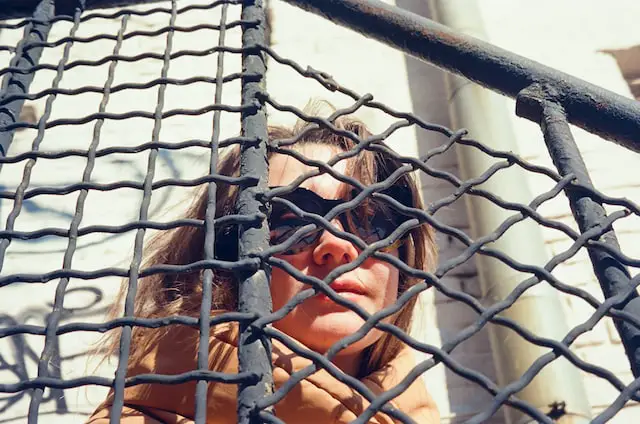

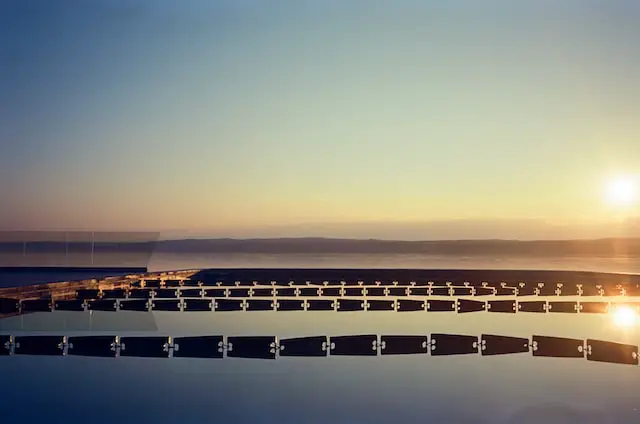
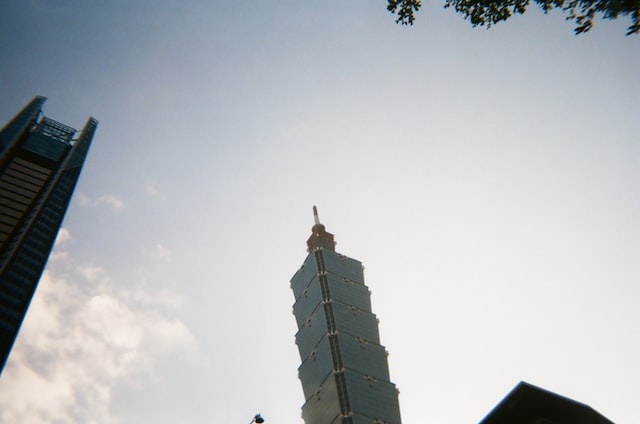
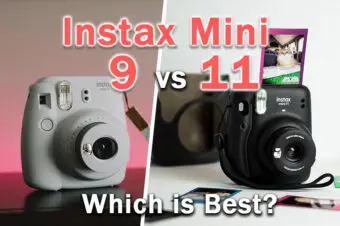
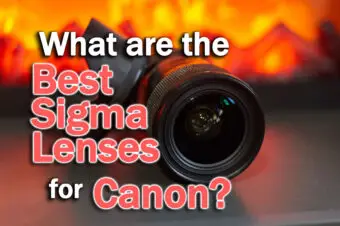
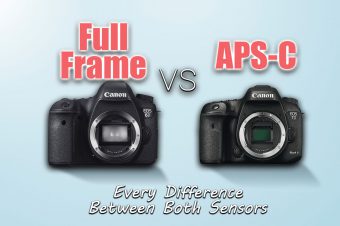
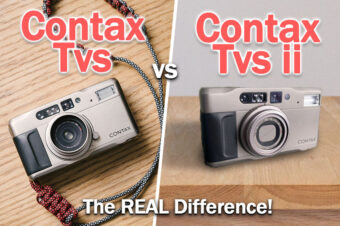

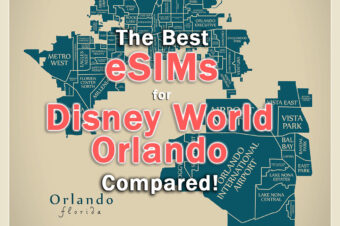
Leave a Reply